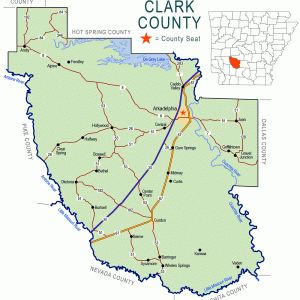calsfoundation@cals.org
Rome (Clark County)
The small community of Rome was once located six miles south of Okolona (Clark County) in western Clark County along the Old Military Road and the Little Missouri River. Today, the only remaining evidence of the once vibrant community is two cemeteries. The community was located in Section 19, Township 9 South, Range 21 West, along present-day state Highway 51.
Rome was founded in the 1850s by a man known as Mr. Dickey, who originated from Corinth, Mississippi. Several families followed Dickey to Rome, drawn by the fertile soil in the area. Among those early settlers were Dickey, Joshua Stewart, and Newt Noland. The first store was established by Noland and was supplied by goods shipped by wagon from Camden (Ouachita County). Stewart also established a store.
The first post office was established in 1851 under the direction of Stewart. In 1885, the post office was permanently discontinued and mail rerouted to Beirne (Clark County). A post office was later opened in the same location in 1897 under the name of Native and was in service until 1900, when mail was routed to Okolona.
The community began to prosper due to its proximity to the Old Military Road, which went to Camden and the Little Missouri River. At its height, the community contained a store, a saloon, and a combination schoolhouse and church, with a Masonic lodge located on the second floor. Later, a new school was built, but it burned shortly after the turn of the century. The church was described as nondenominational and attended by everyone. In 1870, a steamboat traveled up the nearby Little Missouri River and stopped at Rome. The community was described at that time as a “rural but thriving village.”
The community’s demise began in 1874, when the Cairo and Fulton Railroad was built through Gurdon (Clark County), bypassing Rome. Today, only two cemeteries remain to attest to the existence of Rome. The “Old Rome” cemetery located along Highway 51, just over six miles south of Okolona, was used by whites in the community; its oldest grave is dated 1868. The other cemetery, Rome Methodist African American Cemetery, was primarily used by African Americans in the community; its oldest grave is dated 1881. It is located about one mile south of the Old Rome Cemetery.
Today, the site of Rome is nothing but a field; farther down Highway 51, steps lead to Rome Springs, where early settlers went to get their water.
For additional information:
May, Joe. The Way We Were: A Pictorial History of Clark County. Hurst, TX: Curtis Media, 1995.
Richter, Wendy, ed. Clark County Arkansas: Past and Present. Arkadelphia, AR: Clark County Historical Association, 1992.
Ross, Margaret, ed. “Arkansas’ Rome: Few Roads Ever Led to It.” Arkansas Gazette, July 6, 1959, p. 4A.
Jacob Worthan
Henderson State University
 Clark County Map
Clark County Map 




Comments
No comments on this entry yet.